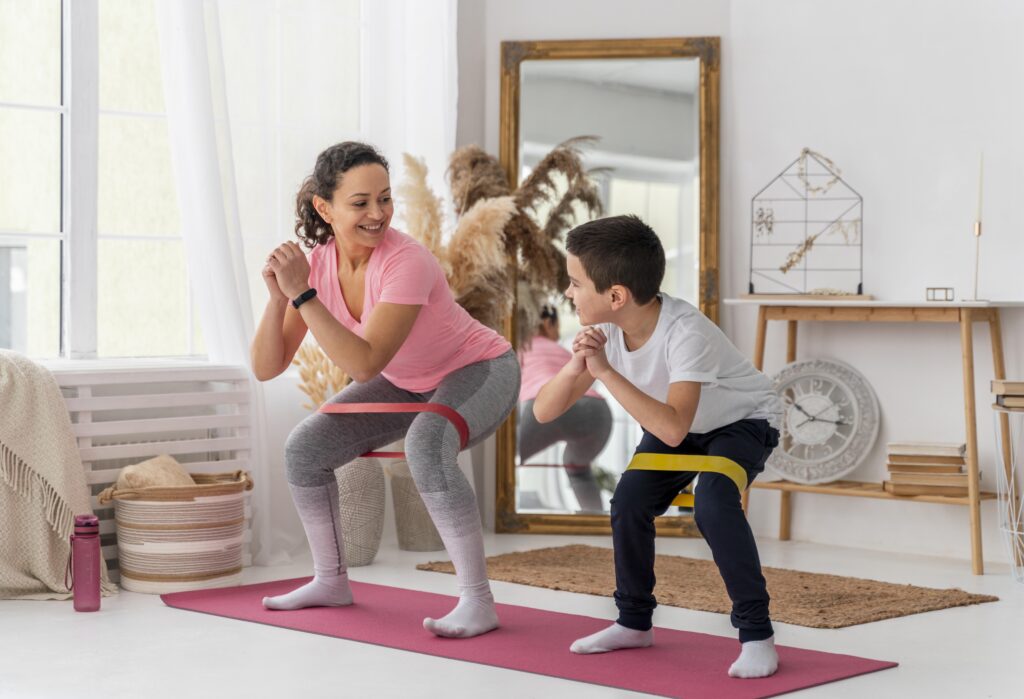Should Your Kids Be Involved In Your Workout Activities

Most parents curiously want to know whether it is right to include our kids in our workout routine.? it is important to know that it’s always joyful to see our kids engage in activities we thought is good, including staying healthy. we all want our children to grow up healthy, confident, and well-rounded. With today’s sedentary lifestyle dominated by screens and structured schedules many of us are asking: whether it is okay to involve our kids in workout activities? The short answer is a resounding yes. but how we do it matters.
Let’s explore the benefits, potential concerns, and tips for including kids into fitness routines in a way that fosters their physical and mental well-being. as we all know kids will always love to engage in any activities, they found fun and seeing their parents’ involvement in exercise will attract them. this article will guide us on how we can involve children into workout routine
The Benefits of Involving Kids in Workout Activities
Encourages Healthy Habits Early On
Children are like sponges, absorbing behaviours and attitudes from their parents. If they see you prioritizing physical activity, they’re more likely to view exercise as a natural and enjoyable part of life.Improves Physical Health
Involving kids in age-appropriate workout activities boosts their cardiovascular health, improves coordination, strengthens muscles, and promotes flexibility. Regular activity also reduces the risk of obesity and related health issues later in life.Builds Confidence and Resilience
Mastering physical skills whether it’s learning a yoga pose or completing a small circuit workout can give kids a sense of achievement. This builds self-confidence and teaches them the value of perseverance.Creates Family Bonding Opportunities
Working out together strengthens family relationships. Shared activities, such as bike rides, hiking, or even at-home dance sessions, are fun ways to connect while staying active fit.Supports Mental Well-Being
Physical activity releases endorphins, the feel-good hormones, which help reduce stress and improve mood. Kids, like adults, can benefit from this emotional boost in our body system.
Potential Concerns to Address
While the advantages are clear, it’s essential to approach workouts with care when involving children.
Avoid Overexertion
Kids have different stamina and physical capabilities compared to adults. Overexerting them with intense or prolonged exercises can lead to fatigue or injuries. Always consider their age and fitness level.Keep It Fun, Not Forced
Forcing kids into workouts they don’t enjoy can create negative associations with exercise. The focus should be on fun and exploration, not performance or competition.Be Mindful of Age-Appropriate Activities
What’s suitable for a teenager might not be appropriate for a toddler. Younger children benefit more from unstructured play and activities that emphasize movement rather than formal workouts.Promote a Healthy Body Image
It’s important to frame workouts as a way to feel strong and healthy, not as a tool for weight loss or appearance. This avoids fostering unhealthy attitudes toward body image.
How to Involve Kids in Workout Activities
Lead by Example
Kids are more likely to join in when they see you enjoying your workouts. Whether you’re doing yoga, jogging, or strength training, invite them to watch or participate.Make It Playful
Turn workouts into games. For example:- Set up an obstacle course in your backyard.
- Have a dance-off in the living room.
- Do “animal movements” like crab walks or frog jumps.
Choose Activities They Enjoy
Ask your kids what they like. Some might prefer biking, while others enjoy swimming or playing soccer. Tailoring activities to their interests makes it more engaging.Involve Them in Planning
Let them feel like part of the process. Ask, “Should we go for a hike today or play basketball?” This gives them a sense of autonomy.Keep It Short and Sweet
Children’s attention spans are shorter, so aim for 15-30 minutes of activity. Break it up into smaller segments if needed.Encourage, Don’t Criticize
Focus on effort and participation rather than perfection. Celebrate their enthusiasm and progress to keep their motivation high.
What Are Some Kid-Friendly Workouts?
- Toddlers and Pre-schoolers: Focus on unstructured play like running, jumping, climbing, and dancing.
- School-Age Kids: Incorporate activities like swimming, biking, or simple strength exercises using their body weight (like push-ups or squats).
- Teenagers: Introduce more structured workouts, such as running, yoga, or even joining you at the gym with proper guidance.
In Conclusion
Yes, it is good to involving kids in workout activities. is not only okay it’s a wonderful way to instil lifelong healthy habits, foster family connections, and support their overall well-being. The key is to make it fun, age-appropriate, and pressure-free.
By turning exercise into an enjoyable shared experience, you’re not just helping your kids stay fit; you’re also creating memories and teaching them the value of movement for both body and mind. And who knows? You might just find yourself having as much fun as they are and also strengthen the family bond as fun and joy is shared in the process of workout routine.